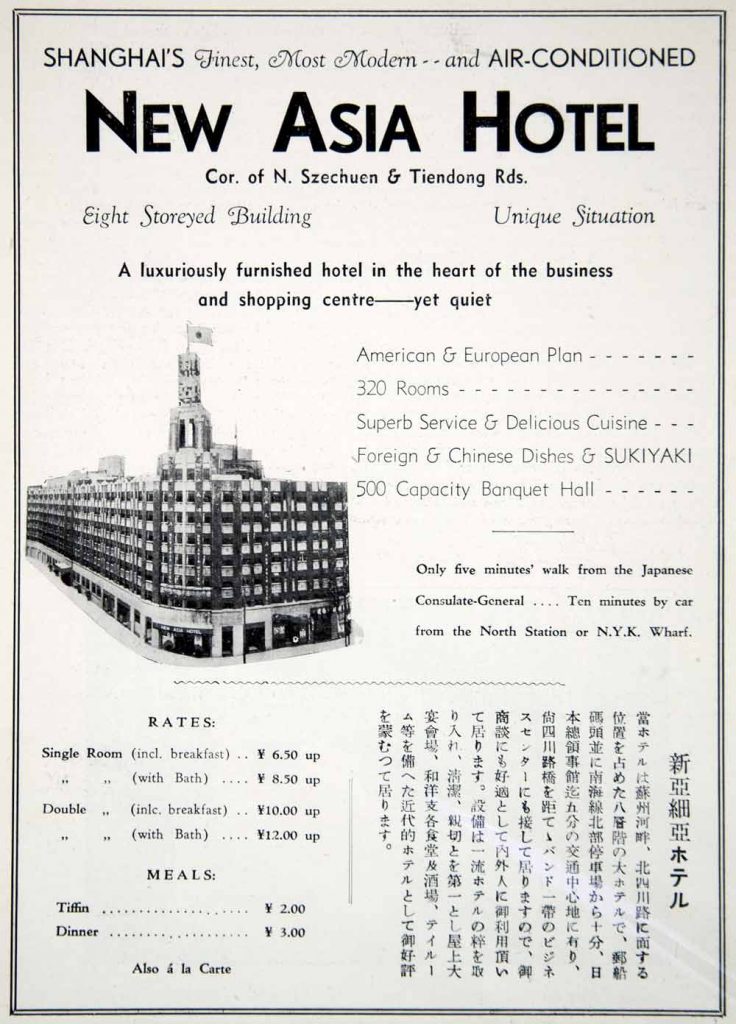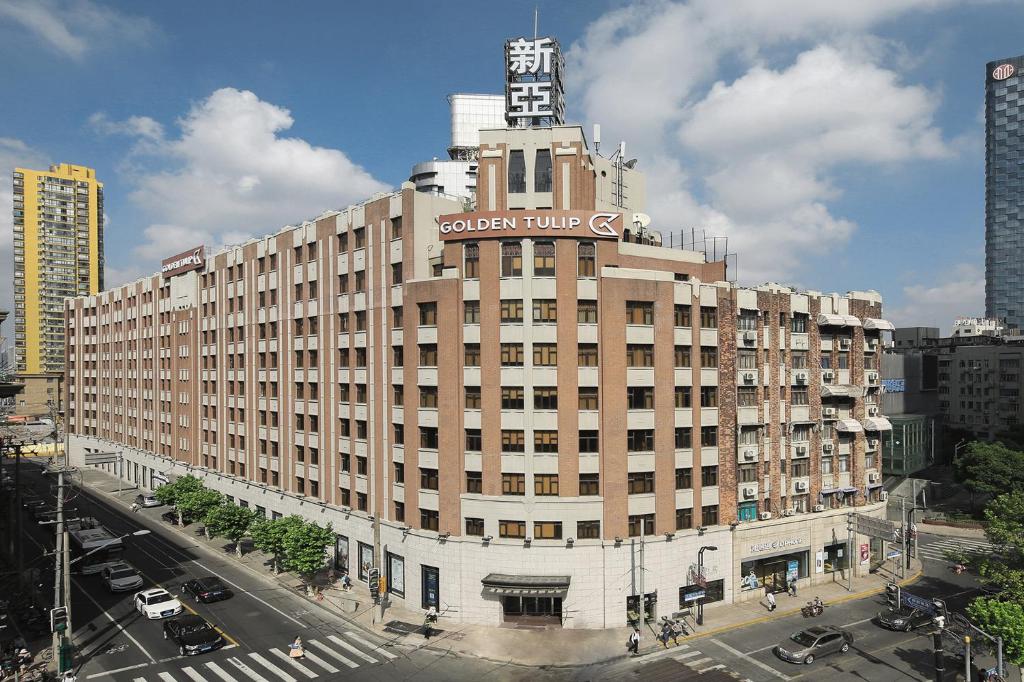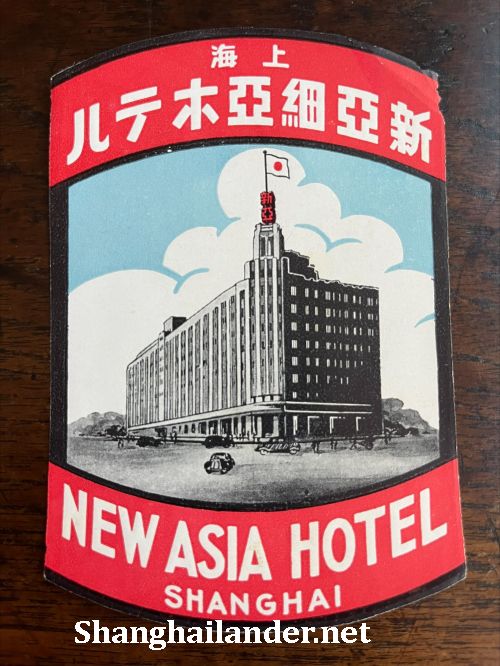Although it is slightly off the beaten track, Honkou’s New Asia Hotel is still an emblematic Art Deco building. Located right behind the Shanghai General Post Office, it is one of the large hotel from Old Shanghai that is still operating until today, like Park Hotel, Cathay Hotel, Yangze Hotel and few others. Having been interested in Old Shanghai hotel and their luggage labels, I recently got the one below, leading to further research about the hotel. If you have missed the previous posts on language labels, please go to post “Old Shanghai hotels luggage labels“.
New Asia Hotel was built in the West of Hongkou district in 1933 and opened in early 1934. It is located right behind the General Post Office, on Sichuan Bei Lu near the bank of the Suzhou Creek. The whole area was being developed then, as the neighboring Embankment Building was built in 1932 and the Bridge House one block behind in 1935. The developer of both buildings was Republic Land Investment 五和洋行, with an architect team headed by S. A. Sayer 席拉 (Thanks to Katya Knyazeva @https://avezink.com/ for the find). New Asia Hotel first open a hotel in Guangzhou in 1928 and Hong Kong on the same year before coming to Shanghai.

The hotel had a distinctive Guandong style, in particular in terms of food. The Hongkou neighborhood had many Japanese residents, so the hotel attracted Japanese clients as well as international travelers as seen as below advertising. The location made it close to the Bund business district, but as also close to Japanese Consulate on the North, the NYK (Japanese Shipping line) wharf and the Japanese Club that was a few streets away in Hongkou district.

Business did not last for very long as the brand new hotel was taken over by the Japanese occupation authorities after 1937. The hotel was used as the headquarter of the Special Services Corp of the Japanese Military Police, as well as base for gangsters linked with it. Being the best hotel in Shanghai out of the foreign area, it also became the residence for Japanese appointed mayor of Shanghai at the time.
The above luggage labels and advertising shows a Japanese flag on the top of the building. Large buildings of the period often showed foreign flags, like British flags on the Bund. My guess is that the luggage label and above document are from the 1934-1937 period, as I don’t see the Japanese occupiers being busy with creating marketing material in English. For more luggage labels from hotels in Old Shanghai, please go to post “Old Shanghai hotels luggage labels“. I recently found another luggage label from New Asia Hotel: See post: “More New Asia Hotel luggage label“.
New Asia Hotel was renovated several times, so the interior has lost all its history, but the Art Deco building still remains today. The hotel is now called Golden Tulip New Asia Hotel.


Thanks Hugues – the New Asia deserves special mention as it was a remarkable diversion from other ‘modern’ Chinese hotels. Before the Japanese arrived the hotel was a moral exemplar. The New Asia Hotel decided to break away from the prevailing standards of Chinese hotels by barring mahjong, women of ill-fame and opium. With branches of the hotel already operating in Hong Kong and Canton, the nine storey Shanghai hotel, situated on the corner of Tiendong and North Szechuen opened in January 1934. The aim of the Cantonese general manager, Mr. Cheng Bew, known to foreigners as Mr. B Jones, was to conduct business along the lines of the foreign hotels where the morals of young men may be preserved and where the charges will be within reasonable reach of the average man’s pocket.
The unusual combination of Christian fellowship and sound business practice brought, to the surprise of many, immediate and lasting success. In it’s first year of operation the hotel received over 72,000 guests. All of the hotel’s 450 staff were meticulously trained in the hotel’s own lecture rooms, with many of them being able to speak English.
The hotel company, in deliberately omitting a ballroom from the hotel, substituted a spacious roof garden for healthy recreation and games. However a small bar was to be found on the ground floor near a club-like lounge and reading room. The hotel invited international patronage, with the Chinese and foreign dining rooms being a favourite lunchtime haunt of Shanghai’s diplomatic circle.
From other notes I made from newspaper I took in the 1980s..
The China Weekly Review May 28th, 1938:
Christian Hotel Converted into den of intrigue…
The New Asia Hotel …has been diverted to strange usage, so strange as to verge on the occult if one would believe all the stories told about the hostelry.
When opened it announced that it would be ‘operated in strict accordance with Christian principles,’ in sharp contrast to some other hotels in the city which catered to ‘the flesh and the devil.’ It had Gideon bibles in every room and was the first ‘strictly modern’ Chinese hotel in Shanghai.
When the Japanese seized the Hongkew area, the Special Service section grabbed the New Asia and established its headquarters there. For a time it was operated by foreigners but now totally Japanese. Now serves as headquarters for around 30 different ‘puppet organisations.’ The New Asia is a hotbed of traitorous activity, housing all manner of organisations which the Japanese warlords are using fro breaking down Chinese resistance or misleading or confusing the public as to what really is going on.’
Secret agents of the organizations are sent into the International Settlement and the French Concession to solicit members. They are plentifully supplied with funds and their main purpose is to invite the prospect to the New Asia for a feat and party. Many Chinese newspapers carried stories of nightly orgies.
The China Daily Tribune 3.3.48
Air Transport under General Chennault – the Flying Tigers, moved into New Asia Hotel after V-J Day, later occupied by the US Army and then the Army Advisory Group in 1948.
Very interesting!! Despite having lived in Shanghai for a number of years, I was not aware of this hotel! The next time I’m there, it will be an interesting destination.
Is it now a hotel?
Thanks for all this information Peter!
Love the labels and the history.
Apparently Poy Gum Lee was a consulting architect on the New Asia Hotel, according to his resume. Not sure what that entailed. He retained shares in the hotel after he returned to New York in 1945.